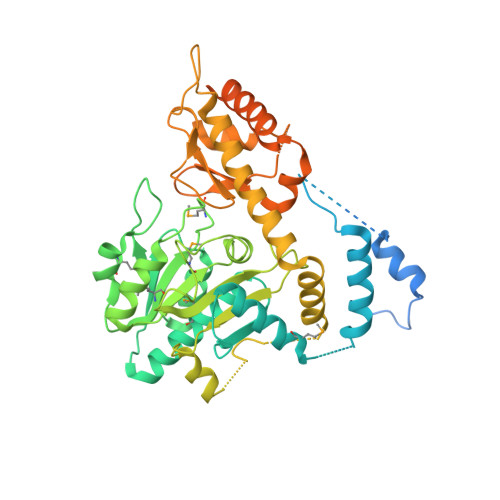Legionella pneumophila S1P-lyase targets host sphingolipid metabolism and restrains autophagy.
Rolando, M., Escoll, P., Nora, T., Botti, J., Boitez, V., Bedia, C., Daniels, C., Abraham, G., Stogios, P.J., Skarina, T., Christophe, C., Dervins-Ravault, D., Cazalet, C., Hilbi, H., Rupasinghe, T.W., Tull, D., McConville, M.J., Ong, S.Y., Hartland, E.L., Codogno, P., Levade, T., Naderer, T., Savchenko, A., Buchrieser, C.(2016) Proc Natl Acad Sci U S A 113: 1901-1906
- PubMed: 26831115
- DOI: https://doi.org/10.1073/pnas.1522067113
- Primary Citation of Related Structures:
4W8I - PubMed Abstract:
Autophagy is an essential component of innate immunity, enabling the detection and elimination of intracellular pathogens. Legionella pneumophila, an intracellular pathogen that can cause a severe pneumonia in humans, is able to modulate autophagy through the action of effector proteins that are translocated into the host cell by the pathogen's Dot/Icm type IV secretion system. Many of these effectors share structural and sequence similarity with eukaryotic proteins. Indeed, phylogenetic analyses have indicated their acquisition by horizontal gene transfer from a eukaryotic host. Here we report that L. pneumophila translocates the effector protein sphingosine-1 phosphate lyase (LpSpl) to target the host sphingosine biosynthesis and to curtail autophagy. Our structural characterization of LpSpl and its comparison with human SPL reveals high structural conservation, thus supporting prior phylogenetic analysis. We show that LpSpl possesses S1P lyase activity that was abrogated by mutation of the catalytic site residues. L. pneumophila triggers the reduction of several sphingolipids critical for macrophage function in an LpSpl-dependent and -independent manner. LpSpl activity alone was sufficient to prevent an increase in sphingosine levels in infected host cells and to inhibit autophagy during macrophage infection. LpSpl was required for efficient infection of A/J mice, highlighting an important virulence role for this effector. Thus, we have uncovered a previously unidentified mechanism used by intracellular pathogens to inhibit autophagy, namely the disruption of host sphingolipid biosynthesis.
- Institut Pasteur, Biologie des Bactéries Intracellulaires, 75724 Paris, France; CNRS UMR 3525, 75724 Paris, France;
Organizational Affiliation:

















